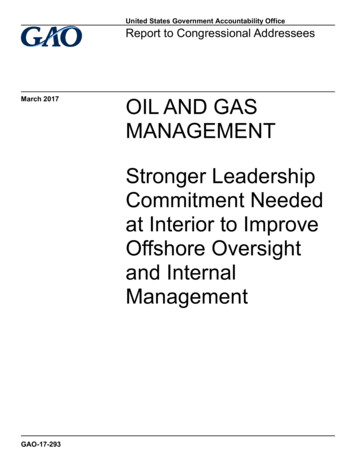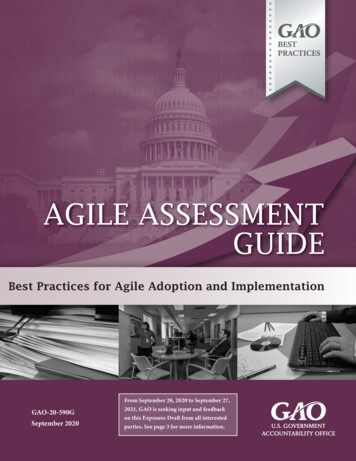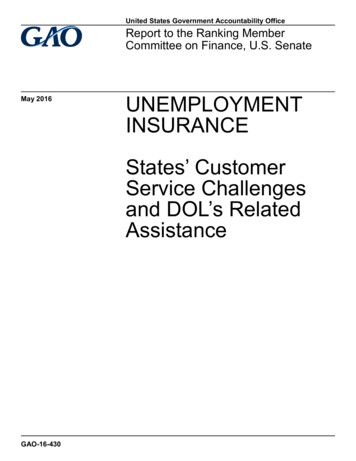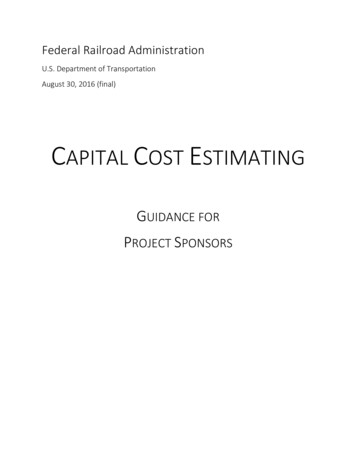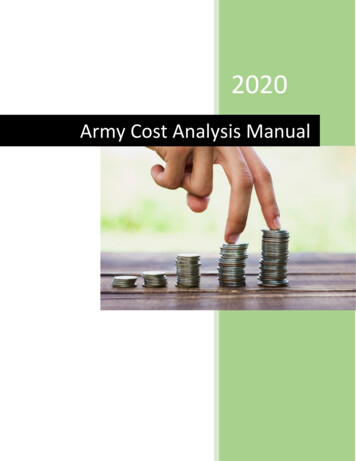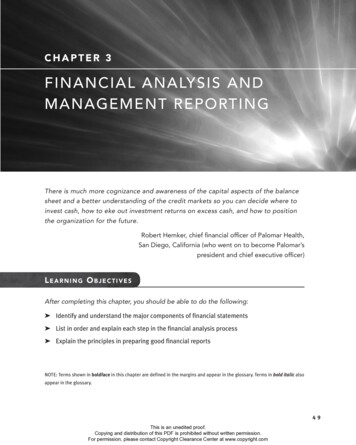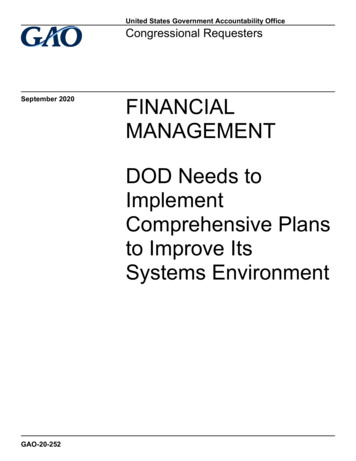
Transcription
United States Government Accountability OfficeCongressional RequestersSeptember 2020FINANCIALMANAGEMENTDOD Needs toImplementComprehensive Plansto Improve ItsSystems EnvironmentGAO-20-252
September 2020FINANCIAL MANAGEMENTDOD Needs to Implement Comprehensive Plans toImprove Its Systems EnvironmentHighlights of GAO-20-252, a report tocongressional requestersWhy GAO Did This StudyWhat GAO FoundDOD financial management hasbeen on GAO’s High Risk List since1995 because of long-standingdeficiencies found in, among otherareas, its supporting informationsystems. DOD uses these systemsto report its spending and assets.Data supporting the Department of Defense’s (DOD) fiscal year 2019 financialstatements are not reliable, according to the DOD Office of Inspector General(OIG) and independent auditors. In January 2020, the OIG reported that thedepartment had wide-ranging weaknesses in its financial management systemsthat prevented it from collecting and reporting financial and performanceinformation that was accurate, reliable, and timely. Specifically, the OIG reported25 material weaknesses that impacted DOD’s ability to achieve an unmodifiedaudit opinion on its fiscal year 2019 department-wide financial statements. Thesematerial weaknesses are based, in large part, on identified deficiencies andcorresponding recommendations, also known as notices of findings andrecommendations (NFRs).GAO was requested to reviewDOD’s financial managementsystems. The objectives of thisreview are to determine (1) to whatextent the data produced by DODfinancial management systems arereported to be reliable for presentingfinancial statements in accordancewith generally accepted accountingprinciples, (2) to what extent DODand the military departments havestrategies and plans to address keyinformation technology controls fortheir financial systems, and (3) howmuch money DOD reports spendingon developing and maintaining itsfinancial management systems.To address these objectives, GAOanalyzed (1) independent publicauditors’ findings resulting fromthe department’s fiscal year 2019audit; (2) DOD’s financialmanagement systems strategyand plans relative to OMBguidance and recent legislation;(3) data in DOD system andbudget databases. GAO alsointerviewed relevant DOD andmilitary service officials.In fiscal year 2019, independent public accountants issued 2,100 new andreissued NFRs to the military services and DOD remediated 26 percent of themilitary services’ NFRs from fiscal year 2018. Of the 2,100 fiscal year 2019NFRs, 1,008 were related to information technology (IT) and cybersecurityissues. Of the 1,008 NFRs, 484 were new and 524 were reissued from previousyears. (See figure.)Figure: IT Notices of Findings and Recommendations Issued by Independent PublicAccountants Based on Audits of Military Services’ Fiscal Year 2019 Financial StatementsTo address the NFRs and DOD’s underlying financial management systemweaknesses, the department has a strategy that fully addresses threerequirements for a comprehensive and effective IT strategic plan; however, itdoes not include measures for tracking progress in achieving the strategy’sgoals. (See table on next page.)View GAO-20-252. For more information,contact Kevin Walsh, 202-512-6151,walshk@gao.gov, or Asif Khan, 202-512-9869,khana@gao.gov.United States Government Accountability Office
What GAO RecommendsDOD Needs to Implement Comprehensive Plans to Improve Its Systems EnvironmentGAO made the following sixrecommendations to DOD:1.Establish performance measuresfor DOD’s financial managementsystems strategy, including targetsand time frames, and how it plansto measure values and verify andvalidate those values.2.Establish a specific time frame fordeveloping an enterprise roadmap to implement DOD’s financialmanagement systems strategyand ensure that it is developed.3.4.5.6.Develop detailed migration plansfor certain key accountingsystems.Establish performance goals withperformance indicators, targetsand time frames, to monitorDOD’s efforts to address ITrelated audit findings.Implement a mechanism foridentifying a complete list offinancial management systemsand related budget data.Limit investments in financialmanagement systems to what isessential to maintain functionalsystems and help ensure systemsecurity until DOD implements theother recommendations.DOD concurred with GAO’srecommendations and describedactions it plans to take to addressthem.Table: GAO Ratings of DOD’s IT Financial Management Systems StrategyIT Strategic Plan RequirementsaAlignment with the agency’s overall strategic planResults-oriented goals and performance measuresStrategies to achieve desired results, including a clear narrativeof how IT is enabling agency goalsDescriptions of dependencies within and across projectsGAO Ratings Legend: Fully addressed: DOD provided evidence that it fully addressed this requirement. Partially addressed: DOD provided evidence that it addressed some, but not all, of thisrequirement.Source: GAO analysis of Department of Defense documentation. GAO-20-252aThe requirements for a comprehensive and effective IT strategic plan are based on Office ofManagement and Budget guidance and prior GAO research and reviews of federal agencies’ ITstrategic plans.DOD has not developed an enterprise road map to implement its strategy, ascalled for by Office of Management and Budget guidance. Such a road mapshould document the current and future states of a systems environment that,among other things, describes business processes and rules, information needsand flows, and work locations and users; and a transition plan for moving fromthe current to the future. In response to recently enacted legislation requiring acomprehensive road map, DOD stated that it plans to develop one; however, itdid not state by when.DOD also does not have sufficiently detailed plans for migrating key militaryservice legacy accounting systems to new systems. The Navy has developed aplan to migrate its system, but the plan is missing key elements consistent withSoftware Engineering Institute guidance. The Army and Air Force do not havedetailed migration plans for their key accounting systems.While DOD has developed a plan to address IT issues identified during annualaudits, it has not established performance goals that include indicators, targets,and time frames. Officials said that it is challenging to develop such goalsbecause issues identified by the IPAs vary widely. However, DOD has alreadygrouped the issues by priority, facilitating the establishment of appropriateperformance goals.Moreover, DOD does not know how much it spends on the systems that supportits financial statements because it does not have a way to reliably identify thesesystems in its systems inventory and budget data. GAO calculated that thedepartment will spend at least 2.8 billion on those systems in fiscal year 2020.However, that amount is understated–GAO identified 45 systems that weremissing from the list of significant systems that DOD provided to GAO.As a result of these deficiencies, the department faces challenges in ensuringaccountability over its extensive resources and in effectively managing its assetsand budgets. DOD also risks wasting funds on short-term fixes that might noteffectively and efficiently support longer-term department goals.GAO-20-252 Highlights
ContentsLetter1BackgroundDOD Cannot Demonstrate That Data Supporting FinancialStatements Are ReliableDOD and the Military Services Lack Comprehensive Plans forImproving Financial Management SystemsDOD Does Not Know How Much It Spends on FinancialManagement Systems; GAO Calculated at Least 2.4 BillionAnnually, but Data Are Not Fully ReliableConclusionsRecommendations for Executive ActionAgency Comments and Our Evaluation6162740434445Appendix IObjectives, Scope, and Methodology48Appendix IISummary of the Department of Defense’s Financial ManagementFunctional Strategy55Key Roles and Responsibilities of the DOD CFO, CIO, andCMO for Financial Management Systems59DOD Spending On New and Legacy Accounting Systems,Fiscal Years 2016 through 202063Appendix VComments from the Department of Defense66Appendix VIGAO Contacts and Staff Acknowledgments67Appendix IIIAppendix IVPage iGAO-20-252 Financial Management
TablesTable 1: Sections of the DOD Annual Financial ReportTable 2: Number of Issues Contained in the Fiscal Year 2019Military Services’ Financial Notices of Findings andRecommendations (NFR)Table 3: Number of Issues Contained in the Fiscal Year 2019Military Services’ Information Technology (IT) Notices ofFindings and Recommendations (NFR)Table 4: GAO Ratings of IT Strategic Plan RequirementsCompared to DOD’s Financial Management SystemsStrategyTable 5: DOD Spending on Development and Modernization andOperations and Maintenance for Systems in DOD’sFinancial Improvement and Audit Readiness (FIAR)System Database, Fiscal Years 2016-2020Table 6: Military Services Spending on New FinancialManagement Systems, Fiscal Years (FY) 2016through 2020Table 7: Department of Defense and the Military ServicesSpending on Legacy Accounting Systems, Fiscal Years(FY) 2016 through 202011212529416465FiguresFigure 1: Transaction Level Data Flowing through Department ofDefense (DOD) Financial Management SystemsFigure 2: Key Components of the Department of DefenseIntegrated Business FrameworkFigure 3: Financial Notices of Findings and RecommendationsIssued by Independent Public Accountants, Based onAudits of the Military Services’ Fiscal Year 2019 FinancialStatementsFigure 4: Information Technology (IT) Notices of Findings andRecommendations Issued by Independent PublicAccountants, Based on Audits of the Military Services’Fiscal Year 2019 Financial StatementsPage ii12152023GAO-20-252 Financial Management
FMFIANFROIGOMBSNAP-ITchief financial officerchief information officerchief management officerDOD Information Technology Portfolio RepositoryDepartment of Defenseindependent public accountantinformation technologyFederal Financial Management Improvement Act of 1996Financial Improvement and Audit ReadinessFederal Information System Controls Audit ManualFederal Managers’ Financial Integrity Act of 1982notice of findings and recommendationsOffice of Inspector GeneralOffice of Management and BudgetSelect and Native Programming-IT SystemThis is a work of the U.S. government and is not subject to copyright protection in theUnited States. The published product may be reproduced and distributed in its entiretywithout further permission from GAO. However, because this work may containcopyrighted images or other material, permission from the copyright holder may benecessary if you wish to reproduce this material separately.Page iiiGAO-20-252 Financial Management
Letter441 G St. N.W.Washington, DC 20548September 30, 2020Congressional RequestersSound financial management practices and reliable, useful, and timelyfinancial information are critical to the Department of Defense’s (DOD)ability to ensure accountability for its extensive resources and its ability toefficiently and effectively manage its assets and budgets. However, DODfinancial management has been on GAO’s High-Risk List since 1995because of long-standing deficiencies found in, among other areas, itssystems. 1 For example, independent public accountants (IPAs) have longreported on the military services’ inability to effectively implementinformation system controls to protect their financial data. 2In addition, the DOD Office of Inspector General (OIG) reported in fiscalyears 2018 and 2019 that DOD did not comply with the Federal FinancialManagement Improvement Act of 1996 (FFMIA). 3 Moreover, DODremains one of the few entities in the federal government that cannotdemonstrate its ability to accurately account for and reliably report itsspending and assets. DOD’s financial management problems remain oneof three major impediments preventing GAO from expressing an opinionon the consolidated financial statements of the federal government.Given the long-standing deficiencies in DOD’s financial management, youasked us to review these systems. Our specific objectives were todetermine (1) to what extent the data produced by DOD financialmanagement systems are reported to be reliable for presenting financialstatements in accordance with generally accepted accounting principles;(2) to what extent DOD and the military services have strategies andplans to address key information technology controls for their financial1GAO,High-Risk Series: Substantial Efforts Needed to Achieve Greater Progress on HighRisk Areas, GAO-19-157SP (Washington, D.C.: March 6, 2019).2Themilitary services are the Army, Navy, Air Force, and Marine Corps.3Departmentof Defense Office of Inspector General, Understanding the Results of theAudit of the DOD FY 2019 Financial Statements (Alexandria, VA: Jan. 28, 2020). FFMIArequires DOD and certain other federal agencies to implement and maintain financialmanagement systems that comply substantially with (1) federal financial managementsystems requirements, (2) applicable federal accounting standards, and (3) the UnitedStates Government Standard General Ledger (USSGL) at the transaction level. Pub. L.No. 104-208, div. A, § 101(f), title VIII, 110 Stat. 3009, 3009-389 (Sep. 30, 1996).Page 1GAO-20-252 Financial Management
management systems; and (3) how much money DOD reports spendingon developing and maintaining its financial management systems. 4To determine to what extent the data produced by DOD’s financialmanagement systems are reported to be reliable for presenting financialstatements in accordance with generally accepted accounting principles,we obtained and reviewed the notices of findings and recommendations(NFR) issued by the IPAs as part of their fiscal year 2019 audits of themilitary services’ financial statements. 5 The IPAs reported the NFRs intwo broad categories, financial and information technology (IT). Inassessing the financial findings, we used the condition statementsdocumented by the IPAs within each NFR to categorize the financialNFRs.In assessing the IT findings, we used the Federal Information SystemControls Audit Manual (FISCAM). 6 Specifically, we reviewed the IT NFRsand summarized them by FISCAM category to identify the key issueslimiting financial data reliability. We also reviewed the DOD Office ofInspector General reports transmitting the results of the military services’audits. To determine what steps DOD is taking to address the NFRs, wereviewed the DOD OIG report describing the DOD components’ NFR4According to FFMIA, financial management systems are the financial systems and thefinancial portions of mixed systems necessary to support financial management, includingautomated and manual processes, procedures, controls, data, hardware, software, andsupport personnel dedicated to the operation and maintenance of system functions. Afinancial system is an information system, comprised of one or more applications, that isused for collecting, processing, maintaining, transmitting, or reporting data about financialevents; supporting financial planning or budgeting activities; accumulating and reportingcosts information; or supporting the preparation of financial statements. A mixed system isan information system that supports both financial and nonfinancial functions. TheDepartment of Defense Financial Management Regulation refers to some mixed systemsas feeder systems. The regulation defines feeder systems as the manual or automatedprograms, procedures and processes which develop data required to initiate anaccounting or financial transaction but do not perform an accounting operation, such aspersonnel, property, or logistics systems.5Anotice of findings and recommendations includes one or more findings and discussesdeficiencies that IPAs identified during the audit along with a correspondingrecommendation(s) for addressing the deficiencies. The IPAs issue both financial andinformation technology NFRs.6GAO,Federal Information System Controls Audit Manual (FISCAM), GAO-09-232G(Washington, D.C.: February 2009). FISCAM presents a methodology for performinginformation system control audits of federal and other governmental entities in accordancewith professional standards.Page 2GAO-20-252 Financial Management
actions and the DOD Financial Improvement and Audit RemediationReport. 7To determine to what extent DOD and the military services havestrategies and plans to address key IT controls, we evaluated thedepartment’s documents describing its strategy for improving its financialmanagement systems. We also determined whether the department hadan integrated road map to implement its strategy. In addition, werequested and reviewed any plans that the department had for effectivelymigrating legacy accounting systems to new systems. We also evaluatedthe department’s plans for addressing IT control issues identified in thedepartment’s financial statement audit. These efforts are discussed inmore detail below. To evaluate the department’s strategy for improving its financialmanagement systems, we reviewed the Department of DefenseFinancial Management Functional Strategy for Fiscal Years 2019 to2023 and the military services’ fiscal year 2019 organization executionplans, which the department said comprise its financial managementsystems strategy. We compared the DOD financial managementsystems strategy with elements of a comprehensive and effective ITstrategic plan, which we derived from Office of Management andBudget (OMB) guidance and our prior research and experiencereviewing federal agencies’ IT strategic plans. 87Departmentof Defense Office of Inspector General, Understanding the Results of theAudit of the DOD FY 2019 Financial Statements (Alexandria, VA: Jan. 28, 2020); Office ofthe Under Secretary of Defense (Comptroller), Financial Improvement and AuditRemediation (FIAR) Report, June 2020.8OMB, Circular No. A-11: Preparation, Submission, and Execution of the Budget, June2018; Circular No. A-130: Managing Information as a Strategic Resource (Washington,D.C.: July 28, 2016); Memorandum M-13-09 Fiscal Year 2013 PortfolioStat Guidance:Strengthening Federal IT Portfolio Management (Washington, D.C.: Mar. 27, 2013);Federal Enterprise Architecture Framework, Version 2, Jan. 29, 2013; and The CommonApproach to Federal Enterprise Architecture, May 2, 2012; and GAO, Social SecurityAdministration: Improved Planning and Performance Measures are Needed to HelpEnsure Successful Technology Modernization, GAO-12-495 (Washington, D.C., April. 26,2012); Defense Business Transformation: Status of Department of Defense Efforts toDevelop a Management Approach to Guide Business Transformation, GAO-09-272R(Washington, D.C.: Jan. 9, 2009); Library of Congress: Strong Leadership Needed toAddress Serious Information Technology Management Weaknesses, GAO-15-315(Washington, D.C., Mar. 31, 2015); and NASA Information Technology: Urgent ActionNeeded to Address Significant Management and Cybersecurity Weaknesses,GAO-18-337 (Washington, D.C.: May 22, 2018).Page 3GAO-20-252 Financial Management
To determine if the department has an integrated road map toimplement its financial management systems strategy, we evaluatedthe department’s efforts to develop an enterprise road map, which is adocument OMB requires federal agencies to develop annually toimplement their IT strategic plans. OMB requires agencies to developan integrated plan that documents the current and future states of abusiness and systems environment at a high level, from anarchitecture perspective, and present a transition plan for moving fromthe current to the future in an efficient, effective manner. 9 Wecompared the information DOD provided to OMB’s requirements. To determine if DOD had migration plans for its key legacy accountingsystems that we identified based on our past and ongoing oversight ofDOD financial audits, we reviewed documentation to ascertainwhether the department had developed plans for the Air Force, Army,and Navy 10 legacy accounting systems. 11 We compared theinformation provided by DOD to leading practices for planningsoftware migrations developed by the Software EngineeringInstitute. 12 To determine to what extent DOD was effectively monitoring its effortsto remediate IT issues, we reviewed the department’s June 2019Financial Management Audit Support Plan, and July 3, 2019,memorandum signed by the Chief Information Officer (CIO), theDeputy Under Secretary of Defense (Comptroller) and the ActingChief Management Officer, on addressing deficiencies in systemaccess controls identified in IT NFRs. 13 In addition, we obtained and9Enterprisearchitecture is intended to provide a clear and comprehensive picture of afunctional or mission area that cuts across more than one organization. It describes theenterprise in logical terms (such as interrelated business processes and business rules,information needs and flows, and work locations and users), as well as in technical terms(such as hardware, software, data, communications, security attributes, and performancestandards).10TheMarine Corps was included in the Department of Navy.11These legacy accounting systems are systems that support the key functions of amilitary service’s financial management and are integral to the financial reporting process,which are planned to be decommissioned, retired, or replaced.12SoftwareEngineering Institute, DOD Software Migration Planning, CMU/SEI-2001-TN012 (Pittsburgh, PA: August 2001). SEI is a nationally recognized, federally fundedresearch and development center established at Carnegie Mellon University in Pittsburgh,Pennsylvania, to address software development issues.13The Acting Chief Management Officer was confirmed by the Senate on December 19,2019, to be Chief Management Officer.Page 4GAO-20-252 Financial Management
reviewed updates on the status of DOD’s efforts to remediate ITissues, which were prepared for DOD officials between February andSeptember 2019. We compared the content of these documents withOMB guidance on establishing performance goals and using them tomeasure progress. 14 Specifically, we assessed the extent to whichDOD’s plans include performance goals with performance indicators,targets, and time frames, and the extent to which the status updatesreport progress. We also conducted interviews with relevant officials in the Office ofthe CIO, the Office of the Under Secretary of Defense(Comptroller)/Chief Financial Officer (hereinafter referred to as theCFO), and the Office of the Chief Management Officer (CMO) todiscuss the development of strategies and plans to guide financialmanagement systems improvement efforts, including plans to addresskey information technology controls for their financial managementsystems.To determine how much money DOD reports spending on developing andmaintaining its financial management systems, we obtained DOD’s list ofsignificant financial and feeder systems from its Financial Improvementand Audit Readiness (FIAR) Systems Database. We matched theidentification number in the list of significant financial and feeder systemswith the identification number in the DOD IT Portfolio Repository toidentify the unique investment identifier associated with each system.Using the unique investment identifiers, which are included in the budgetdata reported on the federal IT Dashboard, we identified the amount DODreported spending on developing and modernizing and operating andmaintaining the financial and feeder systems in fiscal years 2016 through2018 and the amount DOD planned to spend in fiscal years 2019 and2020. 15 We also determined the total amount the department spent infiscal years 2016 through 2018 and the amount it planned to spend infiscal years 2019 and 2020 on new and legacy financial managementsystems.We discussed our approach to determining the spending with officials inthe Office of the CIO and in the Office of the CFO, and they provided14OMB,2018.Preparation, Submission, and Execution of the Budget, Circular No. A-11, June15Thefederal IT Dashboard is a website that enables federal agencies, industry, thegeneral public, and other stakeholders to view details regarding the performance offederal IT investments.Page 5GAO-20-252 Financial Management
comments, which we incorporated. We also assessed the reliability of thedata we used to determine the spending. Specifically, we revieweddocumentation related to the data systems (e.g., user training manuals),discussed the systems and the quality and reliability of the data in themwith department officials, and reviewed the data for obvious issues, suchas missing or questionable values.We determined that the data in DOD’s IT Portfolio Repository and thedata reported on the IT Dashboard were sufficiently reliable for calculatingthe annual costs of the systems in the FIAR Systems Database.However, we determined that many systems and their associated costswere not included in this database. Accordingly, the total amount of costswe determined is understated. Further details about this issue are in thereport. Appendix I contains additional details on our objectives, scope andmethodology.We performed this audit from March 2018 to August 2020, in accordancewith generally accepted government auditing standards. Those standardsrequire that we plan and perform the audit to obtain sufficient, appropriateevidence to provide a reasonable basis for our findings and conclusionsbased on our audit objectives. We believe that the evidence obtainedprovides a reasonable basis for our findings and conclusions based onour audit objectives.BackgroundDOD is the largest U.S. government department and one of the mostcomplex organizations in the world. For fiscal year 2020, DOD’s enactedbudget is 712.6 billion; the President’s Budget for fiscal year 2021requests 705.4 billion. 16 DOD’s discretionary spending is almost half ofthe federal government’s and its reported assets represent approximately75 percent of the federal government’s. The department is one of thenation’s largest employers, with over 2.1 million service members andover 770,000 civilians spread across approximately 4,500 DOD siteslocated in all 50 states, seven U.S. territories, and over 40 countries.DOD’s business systems include financial management systems, humanresource management systems, logistics and supply chain managementsystems, property management systems, and acquisition management16Officeof the Under Secretary of Defense (Comptroller)/Chief Financial Officer, DefenseBudget Overview: United States Department of Defense Fiscal Year 2021 BudgetRequest, February 2020.Page 6GAO-20-252 Financial Management
systems. These systems contribute information that supports thedepartment’s efforts to prepare financial statements.As we have previously reported, the DOD systems environment thatsupports its business functions, including financial management, hasbeen overly complex and error prone, characterized by (1) littlestandardization across the department, (2) multiple systems performingthe same tasks, (3) the same data stored in multiple systems, and (4) theneed for data to be entered manually into multiple systems. 17 For fiscalyear 2020, the department requested about 8.9 billion for its defensebusiness systems.DOD’s AuditRequirementsThe Chief Financial Officers Act of 1990 (CFO Act) required that,beginning with fiscal year 1991, certain federal agencies, including DOD,prepare financial statements covering their revolving funds, trust funds,and components performing substantial commercial functions, and havethose statements audited by the agency’s OIG or by an independentexternal auditor, as determined by the agency’s OIG. 18 The GovernmentManagement Reform Act of 1994, among other things, expanded thescope of these required statements to cover all accounts and associatedactivities of affected agencies, beginning with fiscal year 1996. 19 This actalso required the director of OMB to identify components of federalagencies required to prepare their own audited financial statements. 2017GAO,DOD Financial Management: Implementation Weaknesses in Army and Air ForceBusiness Systems Could Jeopardize DOD’s Auditability Goals, GAO-12-134 (Washington,D.C.: Feb. 28, 2012).18Besides initiating agency financial statement requirements, the CFO Act, Pub. L. No.101-576, 104 Stat. 2838 (Nov. 15, 1990), also established a new federal financialmanagement leadership structure, including chief financial officers to oversee financialmanagement activities at 23 major executive departments and agencies. The list nowincludes 24 entities, which are often referred to collectively as “CFO Act agencies” and iscodified, as amended, in section 901(b) of Title 31 of the United States Code.19TheGovernment Management Reform Act of 1994, Pub. L. No. 103-356, 108 Stat. 3410(Oct. 13, 1994), also added a requirement for government-wide financial statements,beginning with fiscal year 1997, to be prepared by the Secretary of the Treasury andaudited by GAO.20Within DOD, OMB currently requires separate financial statements for: the GeneralFunds of the U.S. Navy, the U.S. Marine Corps, and the Departments of the Army and theAir Force; the Working Capital Funds of the Departments of the Army, the Navy, and theAir Force; the Military Retirement Fund; and the U.S. Army Corps of Engineers CivilWorks Program. See OMB, Bulletin No. 19-03, Audit Requirements for Federal FinancialStatements, app. B (Aug. 27, 2019).Page 7GAO-20-252 Financial Management
After many years of working toward financial statement audit readiness,DOD underwent full financial statement audits in fiscal years 2018 and2019.Congress has periodically enacted laws that added additional conditions,requirements, and due dates for DOD’s efforts to become auditable.Among other things, these have included reporting parameters to assist inmonitoring the department’s financial
DOD’s financial management systems. The objectives of this review are to determine (1) to what extent the data produced by DOD financial management systems are reported to be reliable for presenting financial statements in accordance with generally accepted accounting principles,
